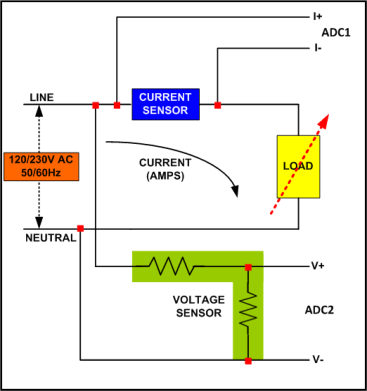SLAA517F May 2012 – August 2021 MSP430F6720A , MSP430F6720A , MSP430F6721A , MSP430F6721A , MSP430F6723A , MSP430F6723A , MSP430F6724A , MSP430F6724A , MSP430F6725A , MSP430F6725A , MSP430F6726A , MSP430F6726A , MSP430F6730A , MSP430F6730A , MSP430F6731A , MSP430F6731A , MSP430F6733A , MSP430F6733A , MSP430F6734A , MSP430F6734A , MSP430F6735A , MSP430F6735A , MSP430F6736 , MSP430F6736 , MSP430F6736A , MSP430F6736A
2 System Diagrams
Figure 2-1 shows typical connections of electronic electricity meters (also called energy meters or e-meters) in real-life applications. The supported ac voltages and associated currents are 230 V or 120 V at 50 Hz or 60 Hz. The labels LINE and NEUTRAL indicate low-voltage ac coming from the utilities.
 Figure 2-1 Typical Connections Inside Electronic Meters
Figure 2-1 Typical Connections Inside Electronic MetersMore information on the current and voltage sensors, ADCs, and other hardware is provided in the following sections.
Figure 2-2 shows a block diagram of the high-level interface that is used for a single-phase energy meter application using the MSP430F6736(A). A single-phase two-wire star connection to the mains is shown with tamper detection. Current sensors are connected to each of the current channels, and a simple voltage divider is used to measure the corresponding voltages. The CT has an associated burden resistor that must be connected at all times to protect the measuring device. The choice of the CT and the burden resistor is done based on the manufacturer and current range required for energy measurements. The choice of the shunt resistor value is determined by the current range, gain settings of the SD24, and the power dissipation at the sensors. The voltage divider resistors for the voltage channel are selected to make sure that the mains voltage is divided down to the normal input ranges that are valid for the MSP430™ SD24. For these values, see the MSP430F5xx and MSP430F6xx Family User's Guide and the device-specific data sheet (MSP430F673x, MSP430F672x Mixed-Signal Microcontrollers and MSP430F673xA, MSP430F672xA Mixed-Signal Microcontrollers).
 Figure 2-2 1-Phase 2-Wire Star Connection Using MSP430F6736(A)
Figure 2-2 1-Phase 2-Wire Star Connection Using MSP430F6736(A)L and N refer to the line and neutral voltages, respectively, and are interchangeable as long as the device is subject to only one voltage and not both simultaneously at its pins. The other signals of interest are the PULSE1 and PULSE2. They are used to transmit active and reactive energy pulses used for accuracy measurement and calibration.